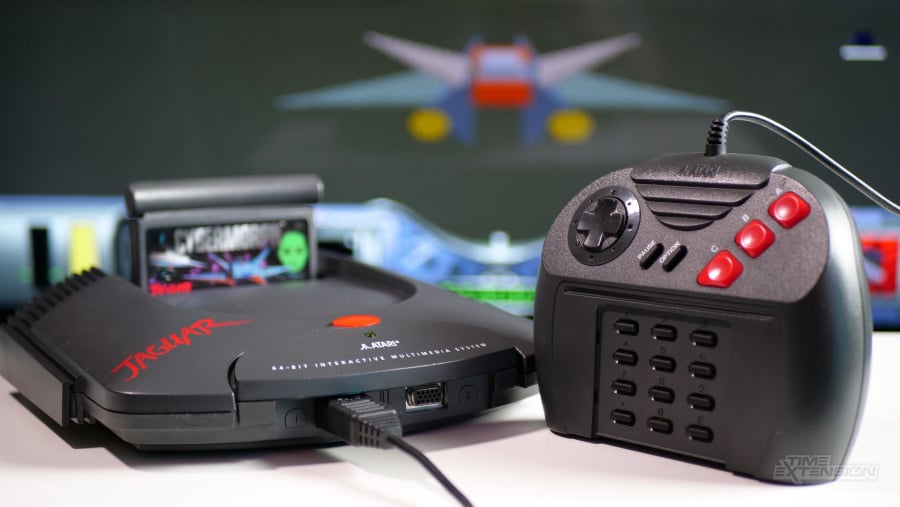
As part of our end-of-year celebrations, we're digging into the archives to pick out some of the best Time Extension content from the past year. You can check out our other republished content here. Enjoy!
Once one of the biggest players in the video game industry, the Atari of today is little more than a brand name that has changed hands numerous times over the past few decades. However, back in the early '90s, the company still had considerable weight in the industry – and it was about to make a last-gasp throw of the dice that would make or break its future.
Atari Jaguar: The History
Atari may have been instrumental in the genesis of arcade and home video gaming, but by the time the 1990s rolled around, its glory days were arguably long behind it. The video crash of 1983 had effectively killed the 'old' Atari, with parent company Warner Communications offloading the consumer electronics and home computer divisions to former Commodore boss Jack Tramiel in 1984 – an event which led to the birth of the new ‘Atari Corporation’. Tramiel's move was viewed by many as a way of getting back at Commodore, the company he had founded in 1953 but was unceremoniously ousted from in '84, but as the '80s drew to a close it was clear that he held court over a fast-diminishing empire.
Atari was floundering on all fronts, and it needed its next venture to hit home.
The wildly successful Atari 2600 was over a decade old, while its successors – the 5200 and 7800 – had both failed to replicate its amazing commercial performance. Meanwhile, it was clear that the former home computer market leader, the ST, was losing the war with the Commodore Amiga, and its 32-bit successor, the Falcon, would be discontinued just a year after its launch in 1992. Elsewhere, the powerful Lynx handheld had found itself in the unenviable position of facing off against the phenomenally successful (yet technically inferior) Nintendo Game Boy and was struggling to find a foothold. Atari was floundering on all fronts, and it needed its next venture to hit home.
The North American veteran identified consoles as the key market, and, just as it had done with the Lynx – which was the brainchild of Epyx staffers R. J. Mical and Dave Needle – Atari looked outside of its own R&D department when it came to sourcing the technology that would power this new system. The team Atari decided to work with was based in the United Kingdom and included two ex-Sinclair Research staffers, Martin Brennan and John Mathieson. Under the company name Flare Technology, the pair had worked on the impressive but ultimately unreleased Konix Multisystem, and Atari negotiated with them to form a new company, Flare II, in order to develop its next gaming platform. As it happened, Flare II worked on two different projects at this time – one based on 32-bit architecture (Panther) and another based on 64-bit architecture (Jaguar). When progress on the latter began to move more swiftly, Atari announced that it had abandoned Panther in 1991 and had decided to focus its attention solely on Jaguar.
Atari officially revealed the Jaguar in 1993 and announced that it had secured a commitment from more than 150 different developers – including the likes of Gremlin Graphics, Microprose, Ocean, Titus, US Gold and Maxis – to produce software for the console. "Jaguar will revolutionise the state of home entertainment," proclaimed Sam Tramiel, son of Jack, who by this point had ascended to the role of Atari president. "It is clearly the wave of the future." Atari further bolstered its standing by securing a strategic partnership with former owner Time Warner, then the world's biggest media and entertainment company, to leverage its enviable video library in the creation of Jaguar products by both Atari and third-party developers, and confirmed that although the console would use cartridges, a CD-ROM drive was also in development. Atari was gearing up for a multimedia war.
On the face of it, the timing of the Jaguar's release seemed perfect; Sega and Nintendo's 16-bit platforms were beginning to show their age, and there was a clear appetite for more powerful domestic hardware
On the face of it, the timing of the Jaguar's release seemed perfect; Sega and Nintendo's 16-bit platforms were beginning to show their age, and there was a clear appetite for more powerful domestic hardware. With a $500 million manufacturing deal in place with computer giant IBM to produce the console – a fact that allowed Atari to plaster a very patriotic 'Made in the USA' notice on the packaging – Atari was poised to swoop in with a sophisticated new platform and save jaded gamers from the flood of samey 2D platformers. Unfortunately, it wasn't the only company thinking along these lines.
Also announced in 1993 was the 3DO Interactive Multiplayer, an attempt by former Electronic Arts boss Trip Hawkins to completely revolutionize the video game industry. Rather than having hardware that was manufactured by a single company, 3DO would make its tech available for licence so that any hardware maker could release their own 3DO-based console and gain an inexpensive foothold in what was set to be a growing sector – a tactic that had paid dividends when it came to the popular CD and VHS standards. Furthermore, 3DO promised much lower licencing fees on software than Sega and Nintendo, making the platform appealing to developers and publishers. A born salesman, Hawkins went on a charm offensive and garnered impressive developer support and plenty of hype in the gaming press, although by the time the 3DO reached store shelves – one month ahead of the Jaguar – its eye-watering $699.99 price point proved unpalatable for many players, while delays on key titles didn't help, either.
While on paper the 3DO seemed to be a powerful rival, Atari had an ace up its sleeve when it came to marketing the Jaguar – while 3DO was 32-bit, Atari’s machine could boast 64-bits of power. Atari pushed the 64-bit angle as far as possible, yet it remains a point of contention that triggers passionate debate even to the present day. In reality, Jaguar was powered by two custom 32-bit RISC chips – 'Tom' (which contained the Graphics processing unit, Object Processor, Blitter and DRAM controller) and 'Jerry' (which handled audio) – both of which were managed by a 16-bit Motorola 68000 system processor – the same workhorse chip that was seen in the likes of the Amiga, Atari ST and Mega Drive.
Atari's director of software development John Skrutch claimed that the Jaguar's setup was so flexible you could hypothetically use the 'Jerry' audio chip to perform other tasks, such as graphical calculations
However, the key distinction here is that data path linking the DRAM, CPU and the 'Tom and Jerry' chips is 64 bits wide, so Atari's claim wasn't entirely without merit. "This is 64-bit architecture,” Sam Tramiel told Next Generation magazine in 1995. “Look at a PC; they call Pentium a 64-bit system, it is, but they also have 8-bit chips and 8-bit parts of the system as well; the clock is 8-bit. In Jaguar there's 16-bit, 32-bit, and 64-bit in parts of it." Speaking to Next Generation's sister publication, EDGE, around the time of the initial announcement, Atari's director of software development John Skrutch claimed that the Jaguar's setup was so flexible you could hypothetically use the 'Jerry' audio chip to perform other tasks, such as graphical calculations.
Debate over precisely how many bits the Jaguar could call upon aside, the hardware nonetheless found favour with some developers. "The thing about the Jaguar is that its power has truly great potential for detailed real-time 3D environments," Rebellion's Jason Kingsley told EDGE in January 1994. "We're really pushing to make the games as interactive as possible." Jeff Minter, the legendary programmer behind titles such as Gridrunner and Attack of the Mutant Camels, told the same magazine in June 1994 that he was "turned on" by the console when it was announced. "As soon as I saw it, it was immediate lust… the other reason I love the Jaguar is it's so easy to program. If you've programmed an ST or an Amiga you can go onto the Jaguar straight away… it just happens to go damn fast as well!"
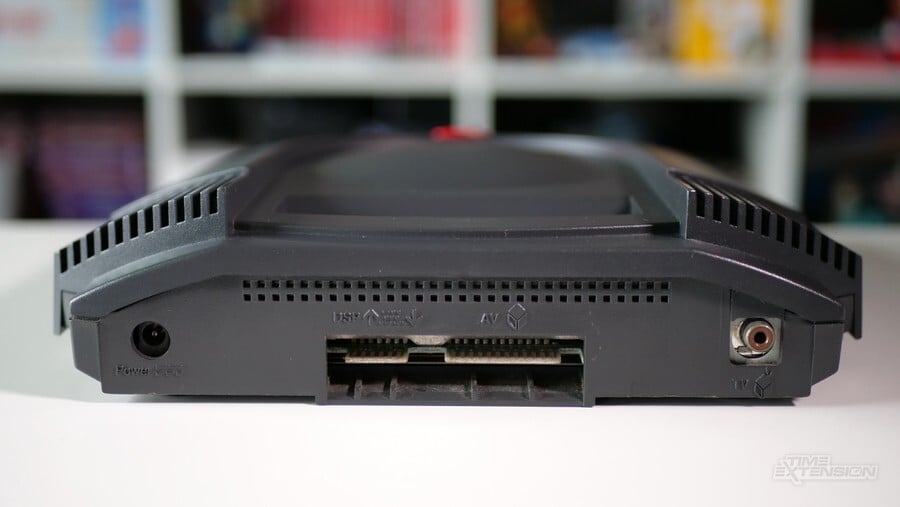
Ominously, though, Attention to Detail's Fred Gill – who worked on the pack-in title, Cybermorph – told EDGE that the Jag was "a very, very powerful system – very underused at the moment. It's going to take people a year or two to get into it, at the very least." Another controversial talking point was the console's controller, which featured just three action buttons but came complete with a 12-button numerical keypad. Games would come packaged with overlays that could be placed on top of the keypad to show which button controlled what function, but critics at the time of release decried Atari’s decision not to include more action buttons (something it would later remedy with a new and improved ‘Pro’ controller).
Another controversial talking point was the console's controller, which featured just three action buttons but came complete with a 12-button numerical keypad
Atari launched the Jaguar on November 23rd, 1993, at a price of $249.99 in North America. The launch was rather muted, with stock only being made available in the select test markets of New York and San Francisco. 20,000 units were sold – the entire stock available, according to Atari – and the machine would see a wider release in early 1994. The pack-in game, Cybermorph, did a fairly good job of communicating the power of Atari's system; while it lacked the slick texture-mapping seen in many 3DO titles, it still offered a visual spectacle that the Mega Drive and SNES couldn’t compete with.
However, like 3DO, Atari lacked the depth of software support required to drive those all-important early sales, while its marketing budget was minuscule compared to what its rivals could call upon. "If it had a Nintendo or Sega badge, nobody would be in any doubt that it's an amazing machine," said Virgin software manager Ian Mathias to EDGE magazine in February 1994. His viewpoint was backed up by Ocean's Gary Bracey, who said in the same issue that, if Nintendo had created the Jag, "we'd be jumping through hoops and shouting from the rooftops." There was clearly an issue not just with Atari's reputation and standing in the industry but also the fact that it couldn't afford to spend millions of dollars convincing consumers that the Jaguar was worth their time. Mega Drive and SNES players simply stuck with their existing machines.
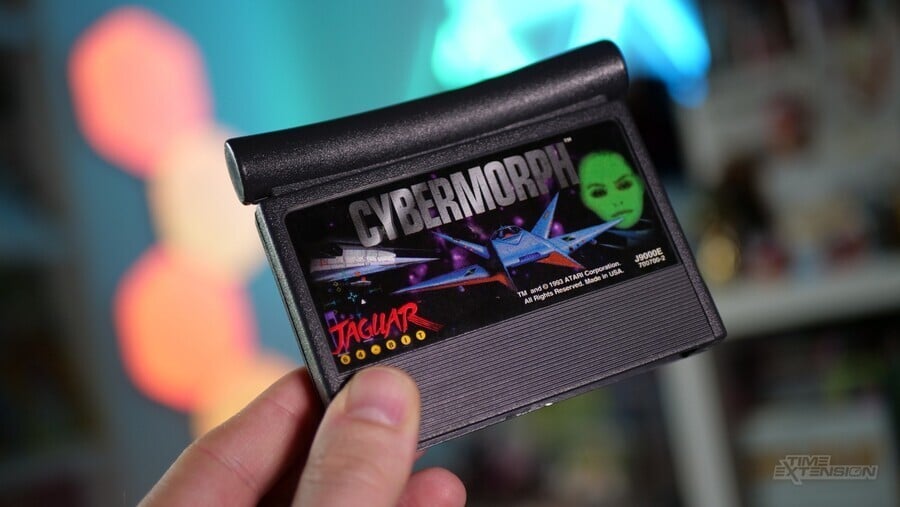
Both the Jaguar and 3DO – along with fellow also-ran the Philips CD-i – would ultimately succumb to a wave of hype relating to a pair of new, more powerful systems that were about to hit the market. Sega's 32-bit Saturn was highly anticipated, mainly due to the fact that Sega was one of the industry's biggest players and Saturn was guaranteed to receive ports of the company's commercially successful coin-op titles, such as Virtua Fighter and Daytona USA. Sega's rival Nintendo wasn't expected to release its Ultra 64 console for some time, but newcomer Sony – still smarting from being jilted by Nintendo on the proposed SNES CD-ROM drive and the all-in-one 'SNES PlayStation' – was preparing to release its own console at the same time. The PlayStation needs little introduction; despite being a rookie in the gaming hardware arena, Sony managed to combine powerful 3D hardware with excellent software support and a respectable price point – all of which ultimately spelt doom not only for Sega but also for 3DO and Jaguar (the less said about Sega's 32X, which was positioned as a rival for the Jag, the better).
The end of 1994 brought the news that Sega had paid Atari $50 million in cash and had purchased $40 million in Atari stock in order to settle a patent dispute that had been rumbling on since 1990
Despite the future looking less than stellar for the platform, Atari backed the Jaguar as much as possible. "Jaguar is as powerful, if not more powerful than Saturn. That we are convinced of, from the technology that we've seen," Sam Tramiel told Next Generation magazine. "The PlayStation, I must say, is a little, little bit more powerful in certain areas – but not in others." There was scant evidence to support such comments, but titles such as Alien vs. Predator (by UK studio Rebellion), Tempest 2000 (coded by the legendary Jeff Minter) and Doom (ported to the Jaguar by id Software's John Carmack himself, who, in June 1994, told EDGE magazine that it was "the best-designed video game hardware around") helped the system gain some much-needed credibility at a point where its future prospects seemed rather dire. Unfortunately, a crippling lack of software support was a problem the Jaguar had to live with during its entire lifespan, and many of the titles that did find their way onto the system were lazy ports of existing 16-bit titles, coded almost entirely with the Motorola 68000 in mind and ignoring the potential of the console's dual 32-bit chips.
This tale very nearly had a twist, however. The end of 1994 saw the PlayStation and Saturn hit Japanese stores but also brought the news that Sega had paid Atari $50 million in cash and had purchased $40 million in Atari stock in order to settle a patent dispute that had been rumbling on since 1990. The case related to patents Atari had held since founder Nolan Bushnell's time with the company. Bushnell is believed to have invested a significant amount of money in protecting Atari's hardware and software innovations during the '70s via more than 70 different patents, and it is thought that one such patent – the 9-pin joystick port – was highlighted as being infringed by Sega (both the Master System and Mega Drive used this port).
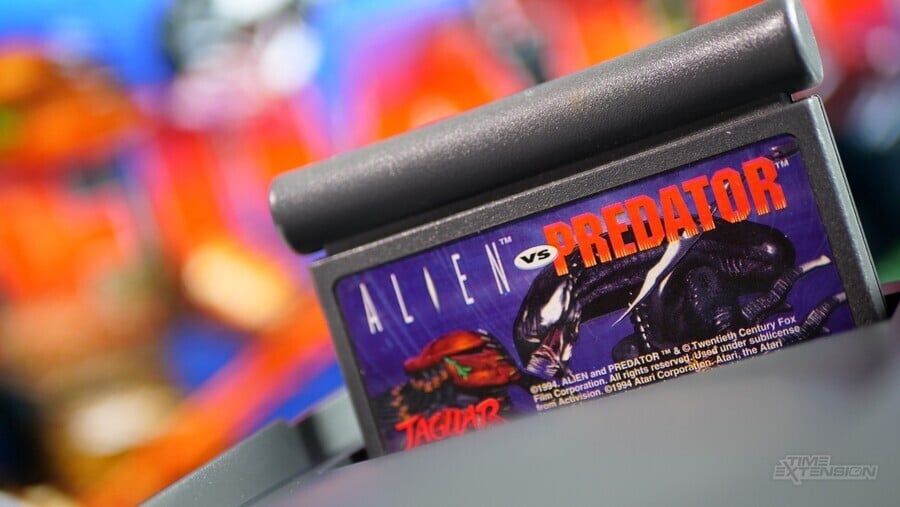
Some journalists voiced the opinion that Sega had capitulated early in order to avoid further legal tussles with Atari over other patents, hence the large sums of money being exchanged. Furthermore, Sega entered into an agreement which was viewed by many as Atari's 'get out of jail' card. "The two companies have entered into a software licence agreement for a specified number of games that would be made available on each company's present and future platforms," said a press release issued by Sega at the time of the settlement. While the line was drawn at Sonic appearing on the Jaguar, there was ample speculation that Atari’s machine could see ports of Virtual Fighter, Daytona USA and many other popular Sega coin-ops, but ultimately it came to nothing; no Sega games ever appeared on the Atari Jaguar. On a related note, a June 1995 deal with publishing giant Electronic Arts to bring the likes of FIFA to the console ultimately came to nothing.
A deal was also inked with UK firm Virtuality to create a headset for the Jaguar that would offer at-home VR for the low cost of $300
Early in 1995, Atari dropped the price to $149.99 / £149.99, making the system significantly cheaper than its competitors. It also launched the console's CD-ROM drive – alongside Cybermorph sequel BattleMorph and Jeff Minter's trippy 'Virtual Light Machine' music player – as well as the aforementioned 'Pro' controller. A deal was also inked with UK firm Virtuality to create a headset for the Jaguar that would offer at-home VR for the low cost of $300; Atari even went as far as to demo the unit at trade shows, although more than one media outlet pointed out that the units were actually rebadged Virtuality headsets. It was another costly distraction for the firm; early in 1996, Atari confirmed that the Virtuality deal had been cancelled but stressed that it was continuing with VR development nonetheless.
Speaking of hardware development, plans were afoot to create a successor system to the Jaguar that would be backwards compatible with all existing Jaguar software. "We're working on a Jaguar 2 right now, as we speak," said Sam Tramiel in an interview with Next Generation magazine. "And Jaguar 2 will be software compatible with Jaguar 1, so all the Jaguar 1 software will be compatible with Jaguar 2… Jaguar 1 has a long life ahead of it at $149. It will be a very successful product. We're here, we're competing, and we will be a major competitor through the '90s. I think that's a really important message." Boasting seven processors spread across three chips – two of which, 'Oberon' and 'Puck' were related to the Jaguar 2's codename of 'Midsummer' (a reference to the William Shakespeare play, A Midsummer Night's Dream), the system planned to support both CDs and cartridges, and was believed to offer three times the processing power of the PlayStation.
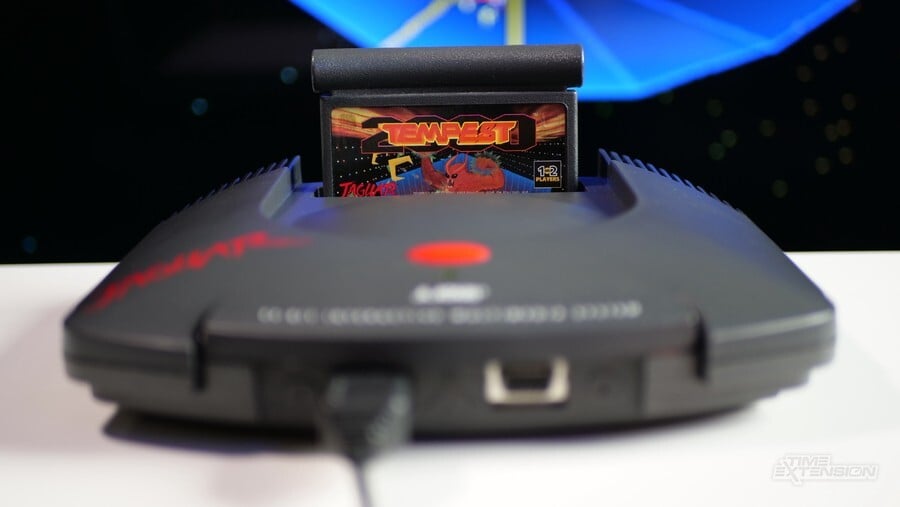
However, despite the bold words, the writing was already on the wall for the Jaguar by this point and the Jaguar 2 wouldn't get beyond the prototype stage. Sam Tramiel suffered a heart attack in 1995 and was replaced as the head of Atari by his ageing father, Jack. By the close of the year, Atari had begun laying off staff and was reported to be looking into shuttering Jaguar development and manufacturing and ending its tentative plans to expand into PC games. In March 1996, it was reported that Atari's president of North American operations, Ted Hoff, had resigned from his position; the departing boss told Next Generation that his hand had been forced due to the fact that "Atari's long-term intentions were not to continue in pursuit of video game development or publishing, neither for Jaguar or Atari Interactive." Atari CFO August Liguori gamely (but perhaps unconvincingly) denied such reports. "We are not going out of the video game industry. We have $50 million and we're going to continue making strategic investments and developing and publishing for all platforms."
Atari's shareholders were informed that revenues had plummeted from $38.7 million in 1994 to $14.6 million in 1995 and that only 125,000 Jaguar consoles had been sold between 1993 and the end of 1995
Despite such assurances, a 10-K405 SEC Filing dated April 12th, 1996 delivered the cold, hard truth. Atari's shareholders were informed that revenues had plummeted from $38.7 million in 1994 to $14.6 million in 1995 and that only 125,000 Jaguar consoles had been sold between 1993 and the end of 1995. Meanwhile, 100,000 Jaguar units remained in stock and unsold at the close of 1995. The news was disastrous.
All that remained was for Atari to find some way of liquidating that stock and moving on from the Jaguar, and in April 1996 it agreed to link up with hard drive maker JTS, Inc. in a reverse merger that would complete in July of the same year. The unsold Jaguar inventory was picked up by private liquidator Tiger Software at the close of 1996, with consoles and games finding their way into video game retail stores at bargain-basement prices. In 1998, JTS sold the Atari brand and its related properties to Hasbro Interactive before filing for bankruptcy a year later.
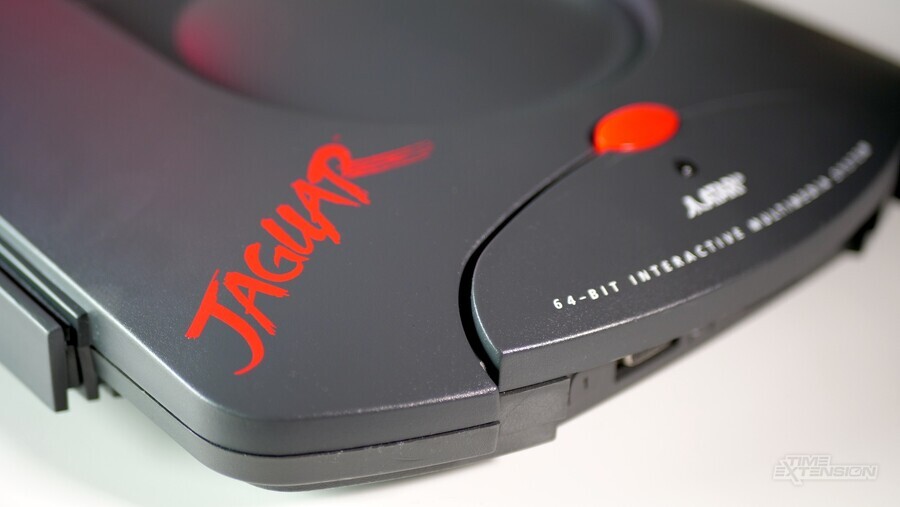
In May of 1999, Hasbro released all patents relating to the Jaguar into the public domain, which meant that developers could create software for it without having to first obtain a license. Richard Cleveland, Head of Marketing for Hasbro Interactive's Atari Business Unit, said: "We realize there is a passionate audience of diehard Atari fans who want to keep the Jaguar system alive, and we don't want to prevent them from doing that. We will not interfere with the efforts of software developers to create software for the Jaguar system." This rather generous gesture meant that a healthy homebrew community quickly grew up around the console, and this led to the release of titles like Rebellion’s impressive Skyhammer in 2000.
The company may be a very different one from that which launched the Jaguar in 1993, but the name lives on regardless
The Jaguar would live on in other ways, too; In 1997, dental imaging equipment maker Imagin Systems purchased the Jaguar console and cartridge moulds from JTS. The console's shell was used to house the company's HotRod camera, while the cartridges were repurposed for memory expansion cards for the same device. This was an odd enough occurrence, but seven years later, Imagin would sell the same moulds to Retro Videogame Magazine founder Mike Kennedy, who was looking to crowdfund a new games console, the Retro VGS. This would later be rechristened the Coleco Chameleon, and the idea was to house the new machine inside the familiar Jaguar casing. After it transpired that two of the prototype consoles Kennedy had demonstrated were fakes, the project collapsed and the moulds found their way into the hands of AtariAge founder Albert Yarusso.
As for Atari, the brand name would be rebooted by French publisher Infogrames when it took over Hasbro Interactive in 2000. More than a decade of corporate upheaval would follow, but the name endures right up to the present day, and Atari has just launched a new piece of hardware, the Linux-based VCS, and is making inroads into the worlds of hotels and NFTs. The company may be a very different one from that which launched the Jaguar in 1993, but the name lives on regardless.






Comments 14
Brilliant article as usual, still would of been great to see the Jag pushed to its full potential. Bad marketing, poor software, always goes to show games will make or break a system seen it many times before. Gameboy destroyed the Lynx and the Gamegear, thanks to Tetris, Super Mario, and that was just for starters.
Loving these articles! These were the types of things I wished I was able to read about when I was a kid!
NINJA APPROVED
Really thorough and a good read - thanks!
I am a proud owner of the Jaguar Toilet Seat, but I only have 2 games
Excellent work. Easily the most comprehensive write-up of the Jaguar I've ever seen. Bravo!
Great article and a strange little console, the power vs Saturn makes me laugh as that's a long way from being true. Though the sound chip theoretically doing other tasks I think is correct, I'm pretty sure Doom uses it for other tasks and that's why it has no music.
It's Doom port is one of the very best of the time and the foundations of Doom console ports for a while. Tempest 2000 is another great game with a stellar soundtrack but sadly it was never realistically going to succeed.
I am looking forward to the Atari 50th anniversary collection which includes some Jaguar games, later this year
Excellent article. I know very little about the Jaguar and its history so this was very educational and interesting. Thanks!
Good timing! I’ve recently been bingeing on Jaguar: Tempest 2000, Iron Soldier, and Super Burnout, all excellent, with some Val D’Isere Skiing and Snowboarding on the side. It’s a neat system that I wish had survived just a little longer.
I wanted one of these, think my parents got tired of spending their money on the ‘latest thing’. I never got one.
Good read this article!
Defender 2000 , Tempest 2000 and Doom were the only games i ever played on the console. For me, the rest were terrible.
Such a shame
This was a terrific article to read i would love to see more Atari Jaguar content on the site. I would especially love to see "making of" articles for these Jaguar games, as we know almost next to nothing about their development process:
Sorry for the wall of text XD but i'm a Jaguar enthusiast
I remember this console coming out, the hype on bad influence and then the lack of support for software and any well known titles. In some ways it was abused in the same way as the 32x - just used to make cheap 16 but ports which then did nothing to convince you to buy into the next gen. At least they got the price right.
Maybe good to note , now it is republished that the emulation of the jaguar is finally get there https://www.youtube.com/watch?v=_7E3EErUMuU
I bought a cheap jag 10 years ago for tempest 2k, such a brilliant game, feels even better than the vita or ps4 version
I wanted one so bad when I was a kid and poor. Could only afford one system and was usually a handheld. Now I have all the systems but no time to play. I wish there would be more challengers to the big three. Some innovation.
Show Comments
Leave A Comment
Hold on there, you need to login to post a comment...